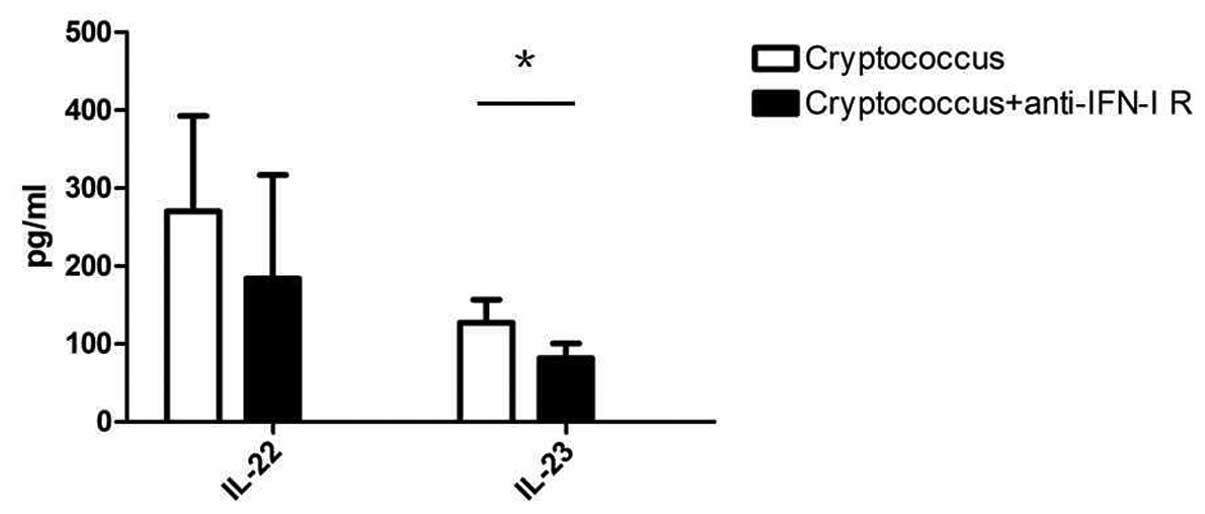|
1
|
Biondo C, Midiri A, Messina L, Tomasello
F, Garufi G, Catania MR, et al: MyD88 and TLR2, but not TLR4, are
required for host defense against Cryptococcus neoformans.
Eur J Immunol. 35:870–878. 2005. View Article : Google Scholar : PubMed/NCBI
|
|
2
|
Nakamura K, Miyagi K, Koguchi Y, Kinjo Y,
Uezu K, Kinjo T, et al: Limited contribution of Toll-like receptor
2 and 4 to the host response to a fungal infectious pathogen,
Cryptococcus neoformans. FEMS Immunol Med Microbiol.
47:148–154. 2006. View Article : Google Scholar : PubMed/NCBI
|
|
3
|
Wormley FL Jr, Perfect JR, Steele C and
Cox GM: Protection against cryptococcosis using a murine gamma
interferon-producing Cryptococcus neoformans strain. Infect
Immun. 75:1453–1462. 2007. View Article : Google Scholar : PubMed/NCBI
|
|
4
|
Wozniak KL, Ravi S, Macias S, Young ML,
Olszewski MA, Steele C and Wormley FL: Insights into the mechanisms
of protective immunity against Cryptococcus neoformans
infection using a mouse model of pulmonary cryptococcosis. PLoS
One. 4:e68542009. View Article : Google Scholar : PubMed/NCBI
|
|
5
|
Peck A and Mellins ED: Precarious balance:
Th17 cells in host defense. Infect Immun. 78:32–38. 2010.
View Article : Google Scholar : PubMed/NCBI
|
|
6
|
Ley K, Smith E and Stark MA:
IL-17A-producing neutrophil-regulatory Tn lymphocytes. Immunol Res.
34:229–242. 2006. View Article : Google Scholar : PubMed/NCBI
|
|
7
|
Bettelli E, Carrier Y, Gao W, Korn T,
Strom TB, Oukka M, Weiner HL and Kuchroo VK: Reciprocal
developmental pathways for the generation of pathogenic effector
TH17 and regulatory T cells. Nature. 441:235–238. 2006. View Article : Google Scholar
|
|
8
|
Korn T, Bettelli E, Oukka M and Kuchroo
VK: IL-17 and Th17 cells. Annu Rev Immunol. 27:485–517. 2009.
View Article : Google Scholar : PubMed/NCBI
|
|
9
|
Ferretti S, Bonneau O, Dubois GR, Jones CE
and Trifilieff A: IL-17, produced by lymphocytes and neutrophils,
is necessary for lipopolysaccharide-induced airway neutrophilia:
IL-15 as a possible trigger. J Immunol. 170:2106–2112. 2003.
View Article : Google Scholar : PubMed/NCBI
|
|
10
|
Chang J, Burkett PR, Borges CM, Kuchroo
VK, Turka LA and Chang CH: MyD88 is essential to sustain mTOR
activation necessary to promote T helper 17 cell proliferation by
linking IL-1 and IL-23 signaling. Proc Natl Acad Sci USA.
110:2270–2275. 2013. View Article : Google Scholar : PubMed/NCBI
|
|
11
|
Jin B, Sun T, Yu XH, Yang YX and Yeo AE:
The effects of TLR activation on T-cell development and
differentiation. Clin Dev Immunol. 2012:8364852012.PubMed/NCBI
|
|
12
|
Barboza R, Câmara NO, Gomes E, Sá-Nunes A,
Florsheim E, Mirotti L, et al: Endotoxin exposure during
sensitization to Blomia tropicalis allergens shifts TH2
immunity towards a TH17-mediated airway neutrophilic inflammation:
role of TLR4 and TLR2. PLoS One. 8:e671152013.PubMed/NCBI
|
|
13
|
Perry AK, Chen G, Zheng D, Tang H and
Cheng G: The host type I interferon response to viral and bacterial
infections. Cell Res. 15:407–422. 2005. View Article : Google Scholar : PubMed/NCBI
|
|
14
|
Rifkin IR, Leadbetter EA, Busconi L,
Viglianti G and Marshak-Rothstein A: Toll-like receptors,
endogenous ligands, and systemic autoimmune disease. Immunol Rev.
204:27–42. 2005. View Article : Google Scholar : PubMed/NCBI
|
|
15
|
Lilly LM, Gessner MA, Dunaway CW, Metz AE,
Schwiebert L, Weaver CT, Brown GD and Steele C: The β-glucan
receptor dectin-1 promotes lung immunopathology during fungal
allergy via IL-22. J Immunol. 189:3653–3660. 2012.
|
|
16
|
Wozniak KL, Hardison SE, Kolls JK and
Wormley FL: Role of IL-17A on resolution of pulmonary C.
neoformans infection. PLoS One. 6:e172042011. View Article : Google Scholar : PubMed/NCBI
|
|
17
|
Clifford JL, Walch E, Yang X, Xu X,
Alberts DS, Clayman GL, et al: Suppression of type I interferon
signaling proteins is an early event in squamous skin
carcinogenesis. Clin Cancer Res. 8:2067–2072. 2002.PubMed/NCBI
|
|
18
|
Frazer LC, Scurlock AM, Zurenski MA, et
al: IL-23 induces IL-22 and IL-17 production in response to
Chlamydia muridarum genital tract infection, but the absence
of these cytokines does not influence disease pathogenesis. Am J
Reprod Immunol. 70:472–284. 2013.PubMed/NCBI
|
|
19
|
Yang CY, Ma X, Tsuneyama K, et al:
IL-12/Th1 and IL-23/Th17 biliary microenvironment in primary
biliary cirrhosis: Implications for therapy. Hepatology. Dec
21–2013.(Epub ahead of print).
|
|
20
|
Dan JM, Wang JP, Lee CK and Levitz SM:
Cooperative stimulation of dendritic cells by Cryptococcus
neoformans mannoproteins and CpG oligodeoxynucleotides. PLoS
One. 3:e20462008. View Article : Google Scholar : PubMed/NCBI
|
|
21
|
Wang JP, Lee CK, Akalin A, Finberg RW and
Levitz SM: Contributions of the MyD88-dependent receptors IL-18R,
IL-1R, and TLR9 to host defenses following pulmonary challenge with
Cryptococcus neoformans. PLoS One. 6:e262322011. View Article : Google Scholar : PubMed/NCBI
|
|
22
|
Redlich S, Ribes S, Schütze S, Eiffert H
and Nau R: Toll-like receptor stimulation increases phagocytosis of
Cryptococcus neoformans by microglial cells. J
Neuroinflammation. 10:712013. View Article : Google Scholar : PubMed/NCBI
|
|
23
|
O’Shea JJ, Steward-Tharp SM, Laurence A,
Watford WT, Wei L, Adamson AS and Fan S: Signal transduction and
Th17 cell differentiation. Microbes Infect. 11:599–611.
2009.PubMed/NCBI
|
|
24
|
Zhou L and Littman D: Transcriptional
regulatory networks in Th17 cell differentiation. Curr Opin
Immunol. 21:146–152. 2009. View Article : Google Scholar : PubMed/NCBI
|
|
25
|
Yosef N, Shalek AK, Gaublomme JT, et al:
Dynamic regulatory network controlling TH17 cell differentiation.
Nature. 496:461–468. 2013. View Article : Google Scholar : PubMed/NCBI
|
|
26
|
Persson EK, Uronen-Hansson H, Semmrich M,
et al: IRF4 transcription-factor-dependent CD103(+)CD11b(+)
dendritic cells drive mucosal T helper 17 cell differentiation.
Immunity. 38:958–969. 2013.PubMed/NCBI
|











